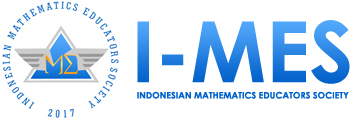An Exploration of Geometrical Concepts in Brunei Woven Textiles: An Ethnomathematical Study
Abstract
Keywords
Full Text:
PDFReferences
Abdullah, A. S. (2017). Ethnomathematics in perspective of sundanese culture. Journal on Mathematics Education, 8(1), 1-16. https://doi.org/10.22342/jme.8.1.3877.1-15
Albanese, V. (2015). Etnomatemática de una artesanía argentina: identificando etnomodelos de trenzado [Ethnomathematics of an Argentine handicraft: Identifying ethno models of trainings]. Bolema: Boletim de Educação Matemática, 29(52), 493-507. https://doi.org/10.1590/1980-4415v29n52a04
Araújo, A. A. (2015). Diseños Prehispánicos, Movimientos y Transformaciones en el Círculo y Formación Inicial de Profesores [Pre-Hispanic Designs, Movements and Transformations in the Circle and Initial Formation of Teachers]. https://doi.org/10.1590/1980-4415v29n52a06
Bisri, I. H., & Muchyidin, A. (2022). Mathematics on Cirebon Woven Textiles with Lanang Motifs. Journal of Mathematics Instruction, Social Research and Opinion, 1(1), 1-13.
Brahim, A. H., Norainna, S. P. H., & Nazurah, F. D. N. (2022). Tawhidic worldview and islamic aesthetics in the art of bruneian tenun (woven textile). In Routledge Handbook of Contemporary Brunei (pp. 311–323). Taylor and Francis. https://doi.org/10.4324/9781003020431-25
D’Ambrosio, U. (2016). An overview of the history of Ethnomathematics. In Current and future perspectives of Ethnomathematics as a program (pp. 5-10). Cham: Springer. https://doi.org/10.1007/978-3-319-30120-4_2
D'Ambrosio, U. (1985). Ethnomathematics and its place in the history and pedagogy of mathematics. For the Learning of Mathematics, 5(1), 44-48. https://www.jstor.org/stable/40247876
de Freitas Madruga, Z. E., & Biembengut, M. S. (2015). Das Relações Entre Modelagem, Etnomatemática e Carnaval: reflexões para aplicação na educação básica. Fronteiras: Journal of Social, Technological, and Environmental Science, 4(2), 31-52. https://doi.org/10.21664/2238- 8869.2015v4i2.p31-52
Deda, Y. N., & Amsikan, S. (2019). Geometry Concept on the Motifs of Woven Textiles in Kefamenanu Community. JRAMathEdu (Journal of Research and Advances in Mathematics Education), 4(1), 23-30. https://doi.org/10.23917/jramathedu.v4i1.6253
Febrian, F., & Astuti, P. (2018). The RME principles on geometry learning with focus of transformation reasoning through exploration on Malay woven motif. Journal of Turkish Science Education, 15(Special), 33-41. https://doi.org/10.12973/tused.10254a
Fouze, A. Q., & Amit, M. (2017). Development of mathematical thinking through integration of ethnomathematic folklore game in math instruction. EURASIA Journal of Mathematics, Science and Technology Education, 14(2), 617-630. https://doi.org/10.12973/ejmste/80626
Freudenthal, H. (1991). Revisiting mathematics education: China lectures (Vol. 9). Cham: Springer Science & Business Media. https://doi.org/10.1007/0-306-47202-3
Karnilah, N., Juandi, D., & Turmudi. (2013). Study Ethnomathematics: Pengungkapan sistem bilangan masyarakat adat Baduy [Ethnomathematics study: Disclosure of the Baduy indigenous system of numbers]. Jurnal Online Pendidikan Matematika Kontemporer, 1(1), 63-74.
Lakapu, M., Uskono, I. V., Jagom, Y. O., Beda, W., Dosinaeng, N., Leton, S. I., & Djong, K. D. (2021). Mathematics in Culture: Analysis of Mathematical Elements in Buna Woven Textiles. Kreano, Jurnal Matematika Kreatif-Inovatif, 12(1), 75-84.
Mukhopadhyay, S. (2009). The decorative impulse: Ethnomathematics and Tlingit basketry. ZDM, 41(1), 117-130. https://doi.org/10.1007/s11858-008-0151-7
Nawawi, N. M., Abdullah, N., Legino, R., Khalid, M. F. M., Ahmad, N. H., Basaree, R. O., & Ismail, N. H. (2015). Classification of frieze patterns in malay songket textile. In International Colloquium of Art and Design Education Research (i-CADER 2014) (pp. 491-500). Springer, Singapore. https://doi.org/10.1007/978-981-287-332-3_51
Nyoni, J. (2014). Indigenising mathematics mediations in South African high schools: Applying Ethnomathematics experiences in teaching and learning. Mediterranean Journal of Social Sciences, 5(15), 327-335. https://doi.org/10.5901/mjss.2014.v5n15p327
Prahmana, R. C. I., & Istiandaru, A. (2021). Learning sets theory using shadow puppet: A study of Javanese ethnomathematics. Mathematics, 9(22), 2938. https://doi.org/10.3390/math9222938
Prahmana, R. C. I., Kusumah, Y. S., & Darhim, D. (2016). Keterampilan mahasiswa dalam melakukan penelitian pendidikan matematika melalui pembelajaran berbasis riset. Beta: Jurnal Tadris Matematika, 9(1), 1-14. https://doi.org/10.20414/betajtm.v9i1.8
Renne, E. P. (1991). Water, spirits, and plain white cloth: The ambiguity of things in Bunu social life. Man, 709-722. https://doi.org/10.2307/2803777
Risdiyanti, I., & Prahmana, R. C. I. (2020). Ethnomathematics Teori dan Implementasinya-Suatu Pengantar. Yogyakarta: UAD Press.
Risdiyanti, I., Prahmana, R. C. I., & Shahrill, M. (2019). The learning trajectory of social arithmetic using an Indonesian traditional game. Elementary Education Online, 18(4), 2094-2108. https://doi.org/10.17051/ilkonline.2019.639439
Rosa, M., & Orey, D. C. (2016). State of the art in Ethnomathematics. In Current and future perspectives of Ethnomathematics as a program (pp. 11-37). Cham: Springer. https://doi.org/10.1007/978-3-319-30120-4_3
Sharbawi, S., & Mabud, S. A. (2021). Malay, Muslim and Monarchy: An introduction to Brunei Darussalam and its national identity. In Globalisation, education, and reform in Brunei Darussalam (pp. 45-66). Palgrave Macmillan, Cham. https://doi.org/10.1007/978-3-030-77119-5_3
Spradley, J. P., & McCurdy, D. W. (1989). Anthropology: The cultural perspective. Reissued Long Grove, IL: Waveland Press.
Tinkong, H. R. B. H., & Mohamad, N. R. (2021). Symbolism in Brunei Malay Wedding Customs. In Engaging Modern Brunei (pp. 239-253). Springer, Singapore. https://doi.org/10.1007/978-981-33-4721-2_14
Wahsalfelah, S. N. H. (2003). Penggunaan Kain Tenunan Tradisional Dalam Masyarakat Melayu Brunei: Satu Tinjauan Awal'. Beriga, 79, 3-17.
Wahsalfelah, S. N. H. (2005). Traditional Woven Textiles: Tradition and Identity Construction in The New State of Brunei Darussalam. (Doctoral Thesis, The University of Western Australia).
Wahsalfelah, S. N. H. (2006). Kain Tenunan Brunei: Warisan, Cabaran dan Masa Depan. Kertaskerja disediakan untuk Persidangan Antarabangsa Pengajian Melayu. Warisan Seni Budaya Melayu: Pelestarian dan Pembangunan Akademi Pengajian Melayu, Universiti Malaya.
Wahsalfelah, S. N. H. (2014). Sejarah Sosio-Budaya Kraftangan di Brunei Darussalam: Barangan Logam dan Kain Tenunan. Susurgalur, 2(1), 29-40.
Refbacks
- There are currently no refbacks.

This work is licensed under a Creative Commons Attribution-NonCommercial-ShareAlike 4.0 International License.
Indonesian Journal of Ethnomathematics
Indonesian Mathematics Educators Society
Jl. Terusan Jend. Sudirman, Kec. Cimahi Tengah, Kota Cimahi, Jawa Barat 40521
E-mail: [email protected]
ISSN: 2775-8001


